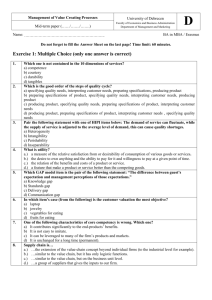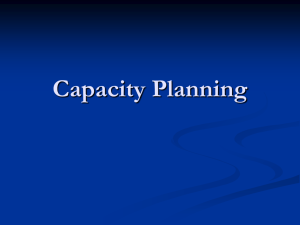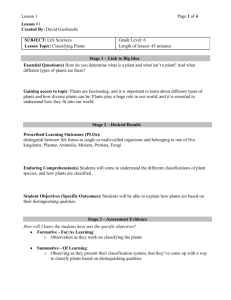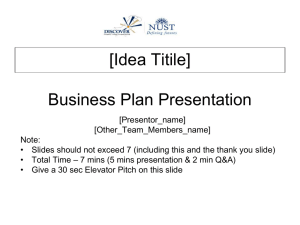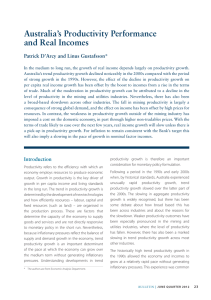Tevékenységmenedzsment
advertisement
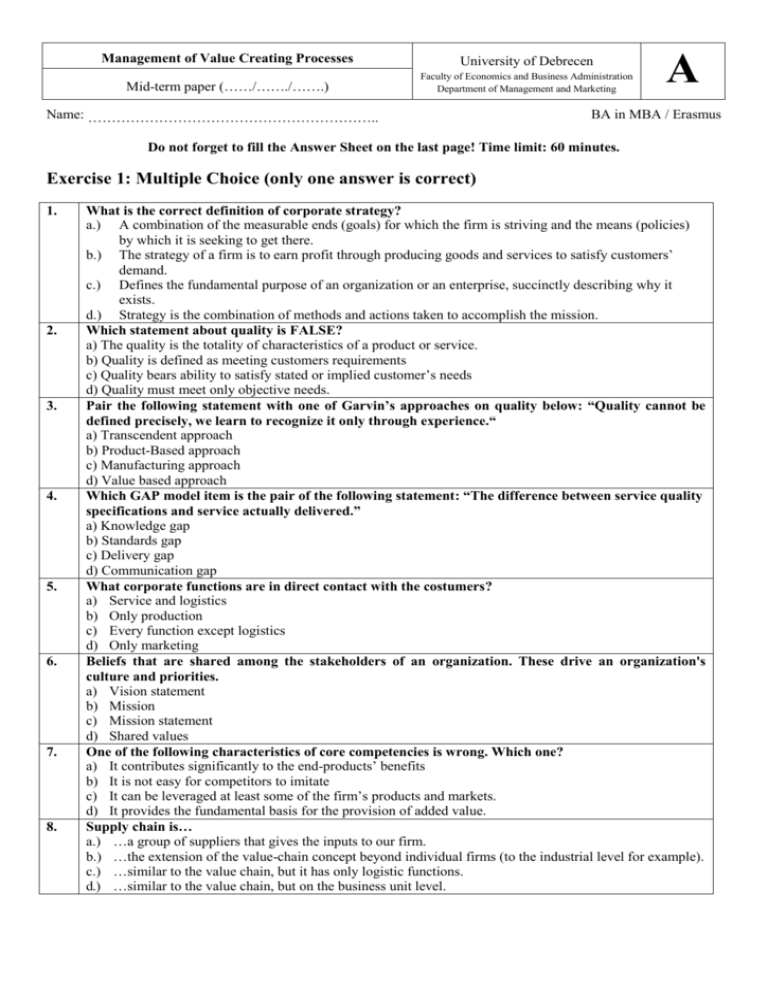
Management of Value Creating Processes University of Debrecen Mid-term paper (……/……./…….) Faculty of Economics and Business Administration Department of Management and Marketing Name: …………………………………………………….. A BA in MBA / Erasmus Do not forget to fill the Answer Sheet on the last page! Time limit: 60 minutes. Exercise 1: Multiple Choice (only one answer is correct) 1. 2. 3. 4. 5. 6. 7. 8. What is the correct definition of corporate strategy? a.) A combination of the measurable ends (goals) for which the firm is striving and the means (policies) by which it is seeking to get there. b.) The strategy of a firm is to earn profit through producing goods and services to satisfy customers’ demand. c.) Defines the fundamental purpose of an organization or an enterprise, succinctly describing why it exists. d.) Strategy is the combination of methods and actions taken to accomplish the mission. Which statement about quality is FALSE? a) The quality is the totality of characteristics of a product or service. b) Quality is defined as meeting customers requirements c) Quality bears ability to satisfy stated or implied customer’s needs d) Quality must meet only objective needs. Pair the following statement with one of Garvin’s approaches on quality below: “Quality cannot be defined precisely, we learn to recognize it only through experience.“ a) Transcendent approach b) Product-Based approach c) Manufacturing approach d) Value based approach Which GAP model item is the pair of the following statement: “The difference between service quality specifications and service actually delivered.” a) Knowledge gap b) Standards gap c) Delivery gap d) Communication gap What corporate functions are in direct contact with the costumers? a) Service and logistics b) Only production c) Every function except logistics d) Only marketing Beliefs that are shared among the stakeholders of an organization. These drive an organization's culture and priorities. a) Vision statement b) Mission c) Mission statement d) Shared values One of the following characteristics of core competencies is wrong. Which one? a) It contributes significantly to the end-products’ benefits b) It is not easy for competitors to imitate c) It can be leveraged at least some of the firm’s products and markets. d) It provides the fundamental basis for the provision of added value. Supply chain is… a.) …a group of suppliers that gives the inputs to our firm. b.) …the extension of the value-chain concept beyond individual firms (to the industrial level for example). c.) …similar to the value chain, but it has only logistic functions. d.) …similar to the value chain, but on the business unit level. 9. 10. 11. 12. 13. 14. 15. One of the following statements characterizes the services. a.) Consumer contact is low. b.) Outputs are highly uniform. c.) They are tangible. d.) They cannot be hold on stock. Linear programming consists of a sequence of steps that lead to an optimal solution to …….. problems, if an optimum exists. (Which of the followings fit sin the gap?) a.) linear-constrained b.) maximization c.) resource-product d.) product-mix Who was the inventor of the Value Chain Concept? a.) Kotler b.) Porter c.) Becker d.) Phelps If the contribution margin per product is 4, the quantity is 2, then the Product’s Contribution to Profit: a.) 8 b.) 2 c.) 6 d.) 0,5 The resource-product matrix: a.) Describes the connections between the company’s resources and products as linear and deterministic relations via coefficients of resource utilization and resource capacities. b.) Describes the minimum that we must, and the maximum that we can sell on the market from each product. It also describes the unit prices and contribution margins per product. c.) Both a.) and b.) are correct d.) Nor a.) neither b.) is correct. If the designed capacity is 20, the capacity used is 10, then the capacity cushion is: a) 100% (1) b) 50% (0,5) c) 200% (2) d) We cannot calculate capacity cushion from these data. If the output rate is less than the optimal level, increasing output rate results in decreasing average unit costs, we call it: a) Economies of scale b) Diseconomies of scale c) Overcapacitation d) Capacity cushion Calculation exercises Exercise 2 What are the optimal production rates (produced quantities) of P1 and P2 products according to the data shown in the matrix below, if we want to maximize the Profits ( = Total Contribution Margin)? P1 P2 b (hrs/y) R1 2 2 5000 R2 3 2 6000 R3 0 2 4000 400 200 MIN (pcs/y) 2000 2500 MAX (pcs/y) 150 50 p (HUF/pcs) 20 30 cm (HUF/pcs) Exercise 3 There is a small company with a total monthly wage of €5000, and 4 machines each have a monthly cost of €500. There are no overhead costs. This company produces 1000 pieces of homogenous goods with a market price of €5 per piece. What are the labour, the machine and the multifactor productivities? Exercise 4 Calculate the following for a year: the Designed Capacity with given work schedule, the Effective Capacity and the realistic quantity of Resource in working minutes we now following data. Number of working days: 250; there are 2 shifts (8 hours each) in a working day; 3 homogenous machines. In every week (there are 52 weeks), there is a maintenance time of 2 hours (for every machine) and the performance percentage is 95%. Answer Sheet Total Points: 30 (15 multiple choice + 15 calculation) Points: …….. / 15 Multiple Choice (maximum points: 15) 1 2 3 4 5 6 7 8 9 10 11 12 13 14 15 Points: ……../ 6 Example 2 (maximum points: 2*3=6) P1 (units/y): P2 (units/y): Example 3 (maximum points: 3*1.5=4.5) Points: ……../ 4,5 Labour productivity: Machine productivity: Multifactor productivity: Example 4 (maximum points: 3*1.5=4.5) Designed Capacity: Effective Capacity: Resource: mins/yr mins/yr mins/yr Points: ……../ 4,5 Answer Sheet Total Points: 30 (15 multiple choice + 15 calculation) Points: …….. / 15 Multiple Choice (maximum points: 15) 1 2 3 4 A D A C 5 6 7 8 A D C B 9 10 11 12 D A B A 13 14 15 A A A Points: ……../ 6 Example 2 (maximum points: 2*3=6) P1 (units/y): 500 P2 (units/y): 2000 Example 3 (maximum points: 3*1.5=4.5) Labour productivity: Machine productivity: Multifactor productivity: 1 2,5 0,71 Example 4 (maximum points: 3*1.5=4.5) Designed Capacity: Effective Capacity: Resource: Points: ……../ 4,5 720000 mins/yr 701280 mins/yr 666216 mins/yr Points: ……../ 4,5
